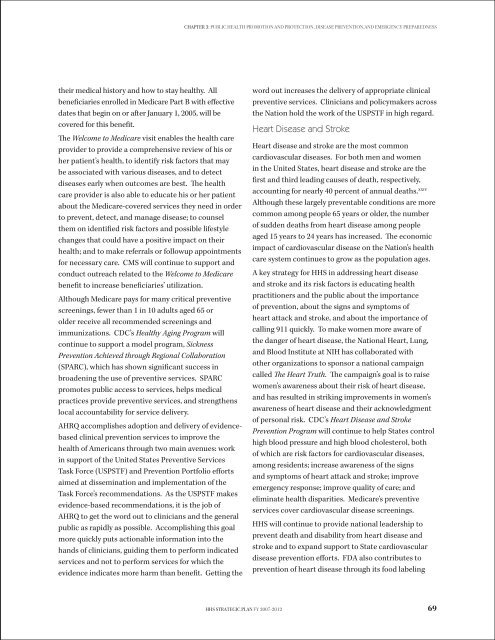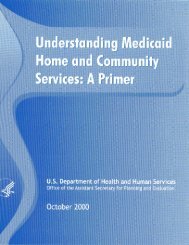STRATEGIC PLAN - ASPE - U.S. Department of Health and Human ...
STRATEGIC PLAN - ASPE - U.S. Department of Health and Human ...
STRATEGIC PLAN - ASPE - U.S. Department of Health and Human ...
Create successful ePaper yourself
Turn your PDF publications into a flip-book with our unique Google optimized e-Paper software.
CHAPTER 3: Public <strong>Health</strong> Promotion <strong>and</strong> Protection, Disease Prevention,<strong>and</strong> Emergency Preparednesstheir medical history <strong>and</strong> how to stay healthy. Allbeneficiaries enrolled in Medicare Part B with effectivedates that begin on or after January 1, 2005, will becovered for this benefit.The Welcome to Medicare visit enables the health careprovider to provide a comprehensive review <strong>of</strong> his orher patient’s health, to identify risk factors that maybe associated with various diseases, <strong>and</strong> to detectdiseases early when outcomes are best. The healthcare provider is also able to educate his or her patientabout the Medicare-covered services they need in orderto prevent, detect, <strong>and</strong> manage disease; to counselthem on identified risk factors <strong>and</strong> possible lifestylechanges that could have a positive impact on theirhealth; <strong>and</strong> to make referrals or followup appointmentsfor necessary care. CMS will continue to support <strong>and</strong>conduct outreach related to the Welcome to Medicarebenefit to increase beneficiaries’ utilization.Although Medicare pays for many critical preventivescreenings, fewer than 1 in 10 adults aged 65 orolder receive all recommended screenings <strong>and</strong>immunizations. CDC’s <strong>Health</strong>y Aging Program willcontinue to support a model program, SicknessPrevention Achieved through Regional Collaboration(SPARC), which has shown significant success inbroadening the use <strong>of</strong> preventive services. SPARCpromotes public access to services, helps medicalpractices provide preventive services, <strong>and</strong> strengthenslocal accountability for service delivery.AHRQ accomplishes adoption <strong>and</strong> delivery <strong>of</strong> evidencebasedclinical prevention services to improve thehealth <strong>of</strong> Americans through two main avenues: workin support <strong>of</strong> the United States Preventive ServicesTask Force (USPSTF) <strong>and</strong> Prevention Portfolio effortsaimed at dissemination <strong>and</strong> implementation <strong>of</strong> theTask Force’s recommendations. As the USPSTF makesevidence-based recommendations, it is the job <strong>of</strong>AHRQ to get the word out to clinicians <strong>and</strong> the generalpublic as rapidly as possible. Accomplishing this goalmore quickly puts actionable information into theh<strong>and</strong>s <strong>of</strong> clinicians, guiding them to perform indicatedservices <strong>and</strong> not to perform services for which theevidence indicates more harm than benefit. Getting theword out increases the delivery <strong>of</strong> appropriate clinicalpreventive services. Clinicians <strong>and</strong> policymakers acrossthe Nation hold the work <strong>of</strong> the USPSTF in high regard.Heart Disease <strong>and</strong> StrokeHeart disease <strong>and</strong> stroke are the most commoncardiovascular diseases. For both men <strong>and</strong> womenin the United States, heart disease <strong>and</strong> stroke are thefirst <strong>and</strong> third leading causes <strong>of</strong> death, respectively,accounting for nearly 40 percent <strong>of</strong> annual deaths. xxivAlthough these largely preventable conditions are morecommon among people 65 years or older, the number<strong>of</strong> sudden deaths from heart disease among peopleaged 15 years to 24 years has increased. The economicimpact <strong>of</strong> cardiovascular disease on the Nation’s healthcare system continues to grow as the population ages.A key strategy for HHS in addressing heart disease<strong>and</strong> stroke <strong>and</strong> its risk factors is educating healthpractitioners <strong>and</strong> the public about the importance<strong>of</strong> prevention, about the signs <strong>and</strong> symptoms <strong>of</strong>heart attack <strong>and</strong> stroke, <strong>and</strong> about the importance <strong>of</strong>calling 911 quickly. To make women more aware <strong>of</strong>the danger <strong>of</strong> heart disease, the National Heart, Lung,<strong>and</strong> Blood Institute at NIH has collaborated withother organizations to sponsor a national campaigncalled The Heart Truth. The campaign’s goal is to raisewomen’s awareness about their risk <strong>of</strong> heart disease,<strong>and</strong> has resulted in striking improvements in women’sawareness <strong>of</strong> heart disease <strong>and</strong> their acknowledgment<strong>of</strong> personal risk. CDC’s Heart Disease <strong>and</strong> StrokePrevention Program will continue to help States controlhigh blood pressure <strong>and</strong> high blood cholesterol, both<strong>of</strong> which are risk factors for cardiovascular diseases,among residents; increase awareness <strong>of</strong> the signs<strong>and</strong> symptoms <strong>of</strong> heart attack <strong>and</strong> stroke; improveemergency response; improve quality <strong>of</strong> care; <strong>and</strong>eliminate health disparities. Medicare’s preventiveservices cover cardiovascular disease screenings.HHS will continue to provide national leadership toprevent death <strong>and</strong> disability from heart disease <strong>and</strong>stroke <strong>and</strong> to exp<strong>and</strong> support to State cardiovasculardisease prevention efforts. FDA also contributes toprevention <strong>of</strong> heart disease through its food labelingHHS Strategic Plan FY 2007-201269
















